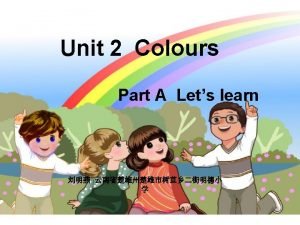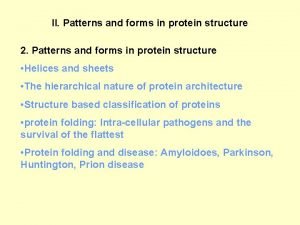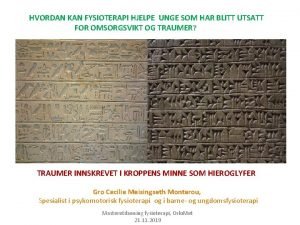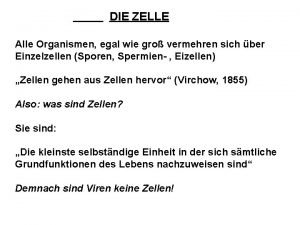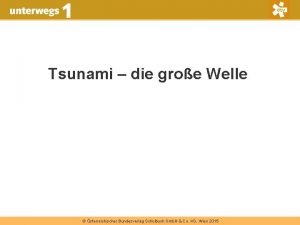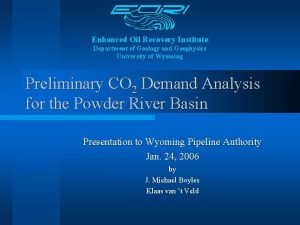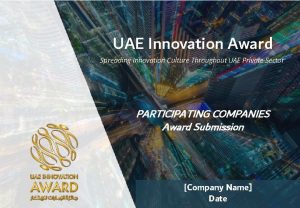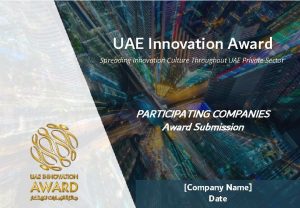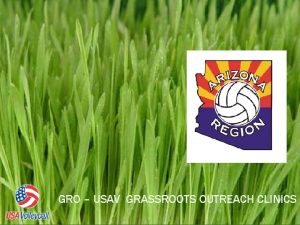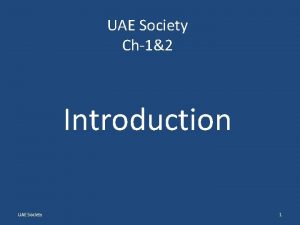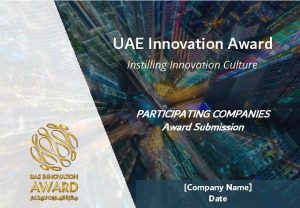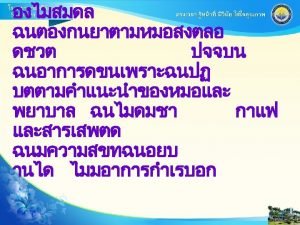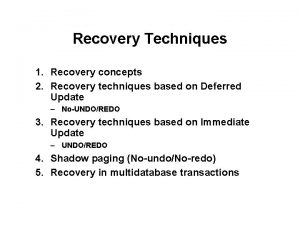Green Oil Recovery GRO UAE Innovation on Oil


















- Slides: 18

Green Oil Recovery (GRO) UAE Innovation on Oil Recovery Dr. Omar Chaalal Associate Professor Abu Dhabi University Page 1

Patented UK Intellectual Property Office, GB 1506690. 5, 3 rd June 2015. “The Secondary and Tertiary Green Water Flooding Of Fractured and Heterogeneous Oil Reservoir at High Salinity and High Temperature” Page 2

Life Cycle of a Well Oil recovery goes into three stages: 1) Primary Phase: At the start of oil production, oil flows naturally to the surface due to existing reservoir pressure 2) Secondary phase: As reservoir pressure drops, water is typically injected to boost the pressure to displace the oil 3) Tertiary Phase: About 30% of the oil is trapped in the reservoir. We need EOR to displace this oil Page 3

Growing need for Enhanced Oil Recovery (EOR) To recuperate this trapped oil, the petroleum industry has devoted billions of dollars for research and development to develop enhanced oil recovery (EOR) technologies and find better methods. Page 4

Forecast of EOR-based Oil Production Page 5

Enhanced Oil Recovery (EOR) methods These are the most Common techniques for EOR: 1. Thermal injection 2. Gas injection natural gas, nitrogen, or carbon dioxide (CO 2) 1. Chemical injection 2. Microbial injection Page 6

Most Popular: CO 2 flooding Advantages Challenges Used at high pressure and reservoir Availability temperature High cost production ( Mixes with the oil to form a low 97% purity) viscosity, low surface tension fluid Transport that can be more easily displaced. Harming environment Has the capability of invading (Global Warming) zones not previously invaded by Corrosions water and releasing trapped oil [The first patent for CO 2 EOR technology was granted to Whorton, Brownscombe, and Dyes of the Atlantic Refining Company in 1952] Page 7

CO 2 vs GRO Recovery Similarity Used at high pressure and reservoir temperature Mix with the oil to form a low viscosity, low surface tension fluid that can be more easily displaced. Have the capability of invading zones not previously invaded by water and releasing trapped oil Both can recover more than 90% of the trapped oil Difference in GOR 1. Very low cost production 2. Raw materials are available 3. Environmentally friendly 4. Applicable for different types of oil reservoir 5. Avoid corrosion (PH 6 -7) 6. Can be used from secondary phase Page 8

G R O reen ecovery il UAE Innovation in Oil Recovery Page 9

Preparation of the Green Water Extract G 1: 1 g of dry (G 1) leaves in 100 ml of water that contains variable concentrations of salt varying from zero ppm to 171600 ppm. Extract (G 2) 1 g of dry (G 2) leaves in 100 ml of water that contains variable concentrations salt varying from zero ppm to 171600 ppm. Extract G 2 Extract G 1: Mixture 80: 20 Green Water Page 10

Physical Characteristics of the Green Water Density and Viscosity at 20 C Interfacial tension (IFT) m. N/m at 20 C G 1 G 2 Viscosity of G 1_80_G 2_20 = 7. 99 m. N/m Page 11

Sugars reduce viscosity and IFT Patent WO 2011049923 A 2 polysaccharide materials as viscosity reducers in petroleum applications. The disclosed hydrophobically modified polysaccharides have been demonstrated to reduce interfacial tension to below 65 m. N/m and thereby improve the transportability of inherently viscous hydrocarbon fluids, such as heavy crude oils. This invention accordingly relates to improved methods of reducing the apparent viscosity of hydrocarbon fluids encountered in petroleum operations to facilitate the flow of such fluids between two locations. In a preferred aspect, the invention relates to reducing the viscosity of petroleum products, such as heavy oil and crude oils, to facilitate its transport out of the subterranean formation or between the site of recovery (e. g. , oil well). These emulsions, in turn, will increase the oil production and provide a cost-effective alternative to heated pipelines or diluents for transportation of heavy oil. Page 12

The mixture 80 -20 % (Our GRO) contains some sugars, proteins, lipids and saponin. The total content of the organic compounds in the mixture is presented in the Table below Compounds Concentrations (mg/l) Fructose 563. 10 Sucrose 179. 50 Maltose 183. 61 Total sugars 926. 21 Proteins 281 Lipids 6 Saponin 13. 6 (mg/gr) 1. 36 % Page 13

Laboratory experimental work Materials: The oil and the water were supplied by the oil company ADCO. The green mixture was provided by the company Aashab. • Oil from Abu Hassa • Brine Water from Um Rudhuma • Green mixture • Four types of cores Page 14

Experimental setup Page 15

Experimental Results (90 o. C) Core Length cm Diameter cm Porosity % Salinity Oil Recovery % 1 8. 22 3. 85 18. 90 86000 77 2 7. 16 3. 84 13. 48 86000 68 3 7. 81 3. 85 19. 80 163054 90 4 5. 22 3. 85 15. 68 170000 96 Page 16

Page 17

THANK YOU ATTENTION Page 18
 Green green green red
Green green green red Tcp gro
Tcp gro Wie gro
Wie gro Gro el
Gro el Gro cecilie meisingseth montarou
Gro cecilie meisingseth montarou Byuyou
Byuyou Pingimg
Pingimg Plasmawachstum
Plasmawachstum Grofar log in
Grofar log in Gro an
Gro an Ein gro
Ein gro Die grö
Die grö Wörter mit gro
Wörter mit gro Mysite socccd
Mysite socccd Radical vs disruptive innovation
Radical vs disruptive innovation Enhanced oil recovery institute
Enhanced oil recovery institute Digital oil recovery
Digital oil recovery Organic oil recovery
Organic oil recovery Difference between creaming and cracking of emulsion
Difference between creaming and cracking of emulsion
